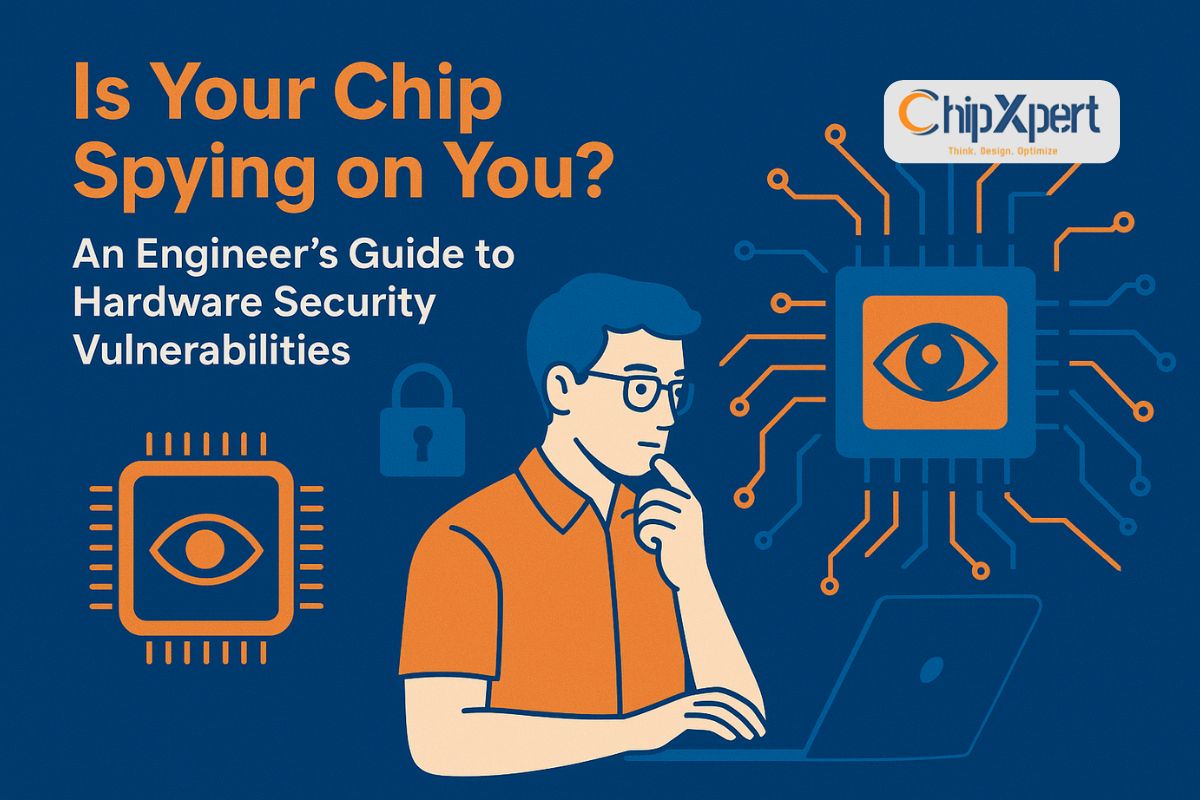Is Your Chip Spying on You? An Engineer’s Guide to Hardware Security Vulnerabilities
We spend billions of dollars and countless engineering hours building digital fortresses. We write impeccable code, deploy sophisticated firewalls, and enforce complex encryption. We picture hackers as shadowy figures trying to pick the digital locks on our front door.
But what if the threat isn’t at the door? What if it’s in the very bricks and mortar of the house itself?
This is the unsettling reality of hardware security. While we’ve been busy fortifying software, a new frontier of vulnerability has emerged at the most fundamental level: the silicon. Two of the most insidious threats in this realm are Side-Channel Attacks and Hardware Trojans. Understanding them is no longer a niche concern; it’s essential for every engineer building our connected future.
The Software Mindset vs. The Physical Reality
Software security operates in a world of ones and zeros—a logical, deterministic realm. Hardware security forces us to remember that chips are physical objects. They consume power, they emit electromagnetic radiation, they get hot, and they take time to compute. These physical characteristics are the very cracks that side-channel attacks exploit.
1. Side-Channel Attacks: The Digital Eavesdropper
Imagine you could figure out what a friend was watching on TV just by listening to the hum of their electricity meter. That’s the essence of a side-channel attack. Instead of attacking the math of the encryption itself, attackers measure the chip’s involuntary physical “body language” to steal its secrets.
Common Types of Side-Channel Attacks:
- Power Analysis: By measuring the tiny fluctuations in a device’s power consumption as it performs operations (like an encryption algorithm), an attacker can literally see the data being processed. Different instructions and data values draw different amounts of power, creating a tell-tale signature.
- Timing Attacks: If a security check takes a fraction of a second longer to fail than to succeed, that tiny timing difference can be measured and used to guess a password or key, one bit at a time.
- Electromagnetic (EM) Analysis: Every current flow in a chip creates a tiny electromagnetic field. Using a sensitive antenna placed near a device, an attacker can capture these emissions and reconstruct the operations happening inside.
The scariest part? These attacks can often be performed with relatively cheap equipment and don’t require physically damaging the chip. They simply listen.
2. Hardware Trojans: The Silicon Sleeper Agent
If a side-channel attack is eavesdropping, a Hardware Trojan is a masterclass in espionage. It’s a malicious, intentional modification of a circuit’s design at some point in the incredibly complex global supply chain.
Think of it like a tiny, malicious circuit—a “sleeper cell”—surreptitiously inserted into a chip’s design. It’s designed to be incredibly small, dormant, and nearly impossible to detect during normal testing. It only “awakens” under a very specific, rare condition.
How Hardware Trojans Work:
- Insertion: A Trojan could be inserted by a rogue employee at a design house, or through compromised third-party IP cores, or even at the foundry during manufacturing.
- Dormancy: It lies inactive, drawing negligible power and not affecting the chip’s primary function. It waits for its “trigger.” This trigger could be a specific counter value (e.g., after 1 million encryptions), a rare signal, or even a specific temperature.
- Payload: Once activated, the Trojan executes its payload. This could be:
- Leaking encryption keys to an external pin.
- Disabling the chip entirely (a “kill switch”).
- Degrading performance or causing rare, difficult-to-diagnose errors.
The challenge of detecting these Trojans is monumental. How do you find a few malicious gates hidden among billions of legitimate ones?
Building a Defensive Moat: How Do We Fight Back?
All is not lost. The hardware security community is innovating with powerful countermeasures:
- Against Side-Channel Attacks: Techniques like masking (splitting sensitive data into random shares) and hiding (making power consumption and execution time constant, regardless of the data) add noise, drowning out the signal attackers rely on.
- Against Hardware Trojans: Strategies include formal verification of designs, trust verification at various stages of the supply chain, and designing circuits with built-in monitors that can detect tiny, anomalous changes in current or delay that might indicate Trojan activity. For a deeper look at where these vulnerabilities can be introduced, our article on Understanding Semiconductor Packaging explores the final, critical step in the manufacturing process.
A Shift in Mindset
Securing the silicon requires a fundamental shift. We must move from thinking purely in terms of logical correctness to thinking about physical behavior. It’s about designing chips not just to be fast and efficient, but to be discreet, leak as little information as possible, and be verifiably trustworthy from the ground up.
In the arms race of cybersecurity, the battlefield has moved to the most foundational layer of technology. For hardware engineers, the mandate is clear: build with security in mind, because the walls have ears.To see a famous real-world example of a side-channel attack, the Spectre vulnerability, you can read this accessible explanation from read here



